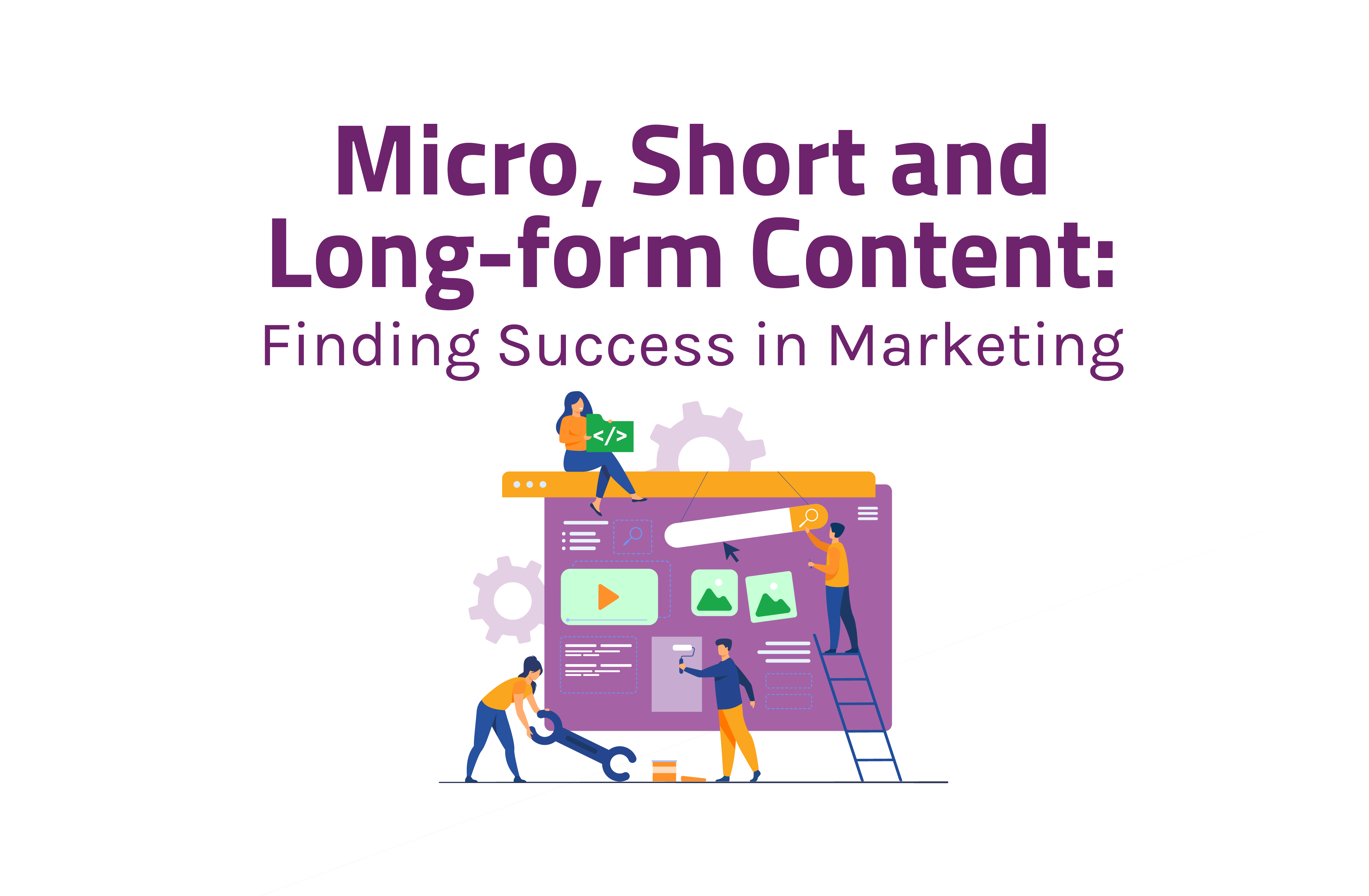Micro, Short and Long-form Content: Finding Success in Marketing

Formerly known as the lip-sync social media platform Musical.ly, ByteDance officially released Tiktok in 2018, intending to further video-focused networking to a global scale. TikTok has changed consumer engagement in just a few years by using a unique algorithmic feed of short videos based on the users' likes and interests.
Other social media networks such as Instagram, Facebook, and Twitter place importance on friends or followers.
Thanks to TikTok’s algorithm, influencers can achieve fame overnight and garner a large following.
According to Forbes, this unique feature led TikTok to win in 2020 after being downloaded 850 million times, creating new opportunities for brands and influencer marketers.
In a 2020 Global Web Index social trends report, brands that showcase their creativity on TikTok become celebrated and appreciated by users.
One automotive case study showed that one influencer marketing campaign garnered 14 million online impressions and 1.9 million likes on the platform.
With its growing success, it’s no surprise that 68% of marketers planned to use TikTok for influencer marketing in 2021.
This Linqia survey showed that the app already stands in second place next to Instagram, given that it’s only in its third year in the market.

Revolutionizing Content Marketing
TikTok's rising popularity didn't happen overnight. Over the decades, content marketing has adapted to the Internet's globalization and has taken the form of various mediums.
“From the rise of Google's demand for Search Engine Optimization in the early 2010s to the popularization of social marketing and the eventual prevalence of video towards the end of the 2010s, content has adjusted time and time again to the demand of the times.”
Today, a sound content marketing strategy shapes your brand's identity, nurtures interest from your target audience, and sustains that engagement until conversion. Moreover, developing great content allows you to position yourself as a thought leader in your industry, increasing your work's credibility.
Your content marketing strategy (or digital marketing strategy) shouldn't remain static. While short-form videos drive a lot of engagement for different companies, it isn't always what your customer needs.
A 15-second ad is more likely to garner clickthrough rates, but it is not enough time to tell a longer, more fleshed-out story.
The same can be said about long-form blogs on your website that can improve audience awareness but don't often perform well with on-the-go consumers.
“There are different ways to reach your audience, so how do you determine if the content you craft should be short-form or long-form?
One word: Context.”
What is Short-Form Content?
Short-form content is around 1,000 to 1,200 words long and is easy to digest instead of too in-depth or detailed.
The goal is usually to get a single message across.
Examples of these include:
- Short blog posts or videos
- News articles or PR Releases
- Infographics
- Visuals or Cards
- Social media posts
- Newsletters
Because the content isn't too heavy on your target audience, it is also relatively easy to create. Brands can use this to engage followers on social media or release short 30-second videos describing their latest product.
With the introduction of social media, creating even shorter versions of your content is often required and appropriate for your chosen channel. Given the purpose of social networking, 15-second videos or GIFs are more practical ways to communicate with prospects and customers.
While it’s not required to be detailed or rich, it’s a gateway to more important information on the brand. And now that most customers are visiting websites through their mobile phones—possibly after scrolling through their social media apps—it is essential to add micro-content to your engagement strategy.
What about Long-Form Content?
Long-form content exceeds the 1,200-word count and delves deep into a topic. This is usually used to educate and inform readers looking for answers to specific questions or topics.
In this way, the content is engaging as much as it is insightful.
Here are some examples of long-form content:
- Lengthy blog posts and pillar pages
- How-tos and guides
- Whitepapers, case studies, and eBooks
- Webinars and virtual events
- > 10-minute Youtube videos
Brands can publish a 2,000-word pillar page that summarizes and compiles all their content on a specific keyword or run a webinar to share the latest trends in the industry.
Given the length of the content, it should be mentioned that it is resource-intensive and takes time to produce.
Long-form content forms are also considered the backbone of many SEO strategies, offering considerable returns in the long run.
Finding the Best Content-Length
“Many marketers have asked: "Does the length of my content matter?"
The short answer is yes, the length of your content matters.However, this shouldn't mean that longer content automatically performs better.”
The length of your content should serve the purpose you created it for and meet the objectives you need to reach.
Long-form and short-form content are merely the means to your end. Neither tool is better than the other, but it is essential to know which one is appropriate for specific situations.
A successful content marketing strategy balances short-form and long-form to meet and answer the questions of their audience.
Instead of creating content that comes to mind, it will significantly benefit brands to understand their audience and how they engage with your product or service.
When deciding to produce long or short-form content, here are some things to remember:
Know Your Content Marketing Goals
Setting clear goals can help marketers plan the best way to meet them. If you want to drive new subscribers to your monthly newsletter, publishing high-quality, long-form articles on your website can invite visitors to sign up.
If your goal is to raise awareness for your products, you can invite influencers to publish a short Tweet (or thread of Tweets) to showcase its uses and benefits.
Understand the User Intent
What does your content serve? What questions does it answer?
When your target audience is interested in specific keywords, it's essential to determine what they want to get out of a piece of content surrounding it.
You will need to work with your Search Engine Marketer (SEM) to identify the audience's intent through their search engine queries.
Short-form is an excellent option to release news snippets when your audience intends to stay up-to-date with the latest news in your industry.
On the other hand, long-form content is a better strategy if your audience wants to be educated on a new type of technology.
Research your competition
It’s also necessary to audit a competitor's similar or relevant content performing well on Search Engine Results Pages (SERPs) and social media. This allows you to determine how you can stand out and explore which keywords you can leverage.
Your competitor might lack informative and interactive collateral.
Your team might then take advantage of this and develop educational content for your website and social media pages. Or you might notice that your competitors use a serious tone when addressing their customers.
You may take this opportunity to use more accurate keywords and put a wittier or humorous spin on your content.
Look at your competitors’ keywords and record which ones you can leverage. Search engine optimization should go hand in hand with your content marketing strategy, so record the word count of ranking blogs and set it as your benchmark
It’s also important to check your competitor’s social media channel strategy:
- How often do they post?
- What is the average engagement and sentiment?
- What design elements do they use?
This research will inform your marketing strategy, allowing you to launch a holistic campaign.
Meet Audience Needs
Finally, observe your audience's behavior. Use the data from these observations to shape your content strategy. This can help you decide if they are more receptive to long-form or short-form content.
One of the successes of influencer marketing on TikTok is that many brands that advertise their products or services target Gen-Z and millennials.
The same can be said for brands with more active LinkedIn or Facebook users. Though the number of users on these platforms is lower, you can still garner a higher engagement rate if your target audience is active there.
The more insights you have on traffic, conversions, and engagement, the better decisions you can make for your content marketing strategy.
Creating the Most Relevant Content
Remember that what works for another business might not work for you. While it might be tempting just to copy what your competitors are doing, you need to find out what works best for you and your customers. You might even be surprised to learn that there’s a niche market on TikTok that you have the potential to reach.
If you don't succeed at first, analyze the data you have, observe the changing trends in technology, and make the appropriate adjustments to your content. Once you discover what makes your audience tick, you can focus your efforts and drive success.
Content creation is also a consistent effort in optimization and improvement.
And, no, it doesn’t always have to be on TikTok (or any micro-content).








Comments